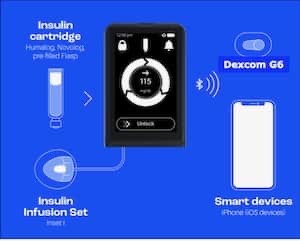Updates on Automated Insulin Delivery
By Matthew Garza
 Automated insulin delivery systems are becoming more advanced and over time have become more widely adopted within the diabetes community. At ATTD 2022, experts presented updates on this emerging technology including results on the iLet Bionic Pancreas and MiniMed 780G.
Automated insulin delivery systems are becoming more advanced and over time have become more widely adopted within the diabetes community. At ATTD 2022, experts presented updates on this emerging technology including results on the iLet Bionic Pancreas and MiniMed 780G.
At the ATTD 2022 conference, leading experts in diabetes technology presented data from a number of exciting trials investigating the use of automated insulin delivery (AID) and insights from an international consensus meeting on AID.
International Consensus Meeting on Automated Insulin Delivery
In the session, Professors Moshe Phillip, Revital Nimri, and Thomas Danne, shared the stage to discuss the international consensus meeting on AID. Some of the most meaningful recommendations presented by the experts included:
-
The need to make AID systems available to all people with type 1 diabetes – paying special attention to the barriers such as race and socioeconomic status that may prevent people from accessing this technology.
-
Strongly encouraging all payers (both private and government) to reimburse or cover the cost of AID systems and education for people with type 1 diabetes.
-
The need for rigorous, comprehensive, and personalized education around AID
-
Specific guidance around clinical recommendations such as exercise management, timing of user-initiated doses, and sick day management.
iLet Bionic Pancreas
Outside of general AID recommendations, researchers also highlighted data from several specific systems. One of those systems is the buzzworthy iLet Bionic Pancreas. This AID device boasts several features that take it one step further than other available systems towards being a fully closed-loop device.
Dr. Steven Russell, associate professor of medicine at Harvard Medical School and Massachusetts General Hospital Diabetes Research Center, explained the benefits of some of these features. For example, he said, when someone starts on the device, all that is needed is their weight (no insulin dosing information). After that, the system constantly adjusts to the user's need, only requiring input when setting the glucose target (Usual, Lower, Higher) and when eating (meal type and meal size, but does not require any carb counting). All correction doses are automated.
The pivotal study looking at the iLet Bionic Pancreas (insulin only version) included 440 adults and children who were on a range of insulin delivery systems at the start of the trial. The participants were randomized to use either the iLet bionic pancreas (with Humalog and Novolog), or their current method for insulin delivery with a Dexcom G6 continuous glucose monitor (CGM). A subsection of adult participants were also randomized to use the bionic pancreas with Fiasp insulin.
After the 13 week trial, results showed the iLet Bionic Pancreas led to improvements in A1C, Time in Range (TIR), and average glucose levels at every hour of the day. Those using the bionic pancreas saw their average A1C decrease 0.5 percentage points from 7.9% to 7.3% while those in the control group saw no significant change in A1C.
These results were greater for those who had an A1C greater than 7.0%; this group had an average A1C drop of 0.7 percentage points.
“Those that needed the benefits the most saw the largest reductions in A1C,” Russell said.
Additionally, TIR improved by around 11 percentage points or around 2.6 hours per day (this was even higher in the adult-only group who had improvements as great as 3.1 hours per day).
“It’s worth pointing out here that our increase in Time in Range occurred almost all within the first day or two,” Russell said.
The bionic pancreas also did not increase hypoglycemia compared to the group using their previous insulin delivery systems.
Russell and colleagues are also actively working on a dual hormone device that includes both insulin and glucagon, with the insulin working to lower blood glucose and the glucagon to raise it.
MiniMed 780G
The MiniMed 780G, which was approved in Europe in 2020 but not yet in the US, has now been on the market for long enough that real-world data showing its benefits is readily available.
Dr. Robert Vigersky, chief medical officer, Global Medical and Clinical Affairs at Medtronic Diabetes, presented some of this data from the past year and a half. In over 25,000 users, TIR was 74.3%, on average, glucose management indicator (GMI) was 6.8%, and time spent in hybrid closed-loop (HCL) was around 91%. Additionally, more than half of the users achieved all three goals of a TIR greater than 70%, GMI less than 7% and Time Below Range (TBR) less than 4%.
Vigersky highlighted that these results were relatively consistent across all countries included in this data. And he showed data that split the group into quartiles based on their starting TIR.
“If you’re in the first quartile and you only have 45% Time in Range, when you initiate HCL, you get a very robust [increase] to almost 70%,” he said. He added that even those in the highest quartile, who came into the analysis already having an 80% Time in Range, got a small boost of 2 percentage points, but more significantly, they also got a decrease of Time Below Range from 3.4 to 2.5%.
“So essentially,” Vigersky said, “everybody seems to be able to benefit regardless of where you’re starting.”
Though there are limitations to real-world data that prevent researchers from being able to say what caused some of these results, the data nevertheless provides insights into how this system can improve glucose levels for users and what factors might influence the benefits and risks of the system.
To learn more about AID, check out our resources on these systems here.








